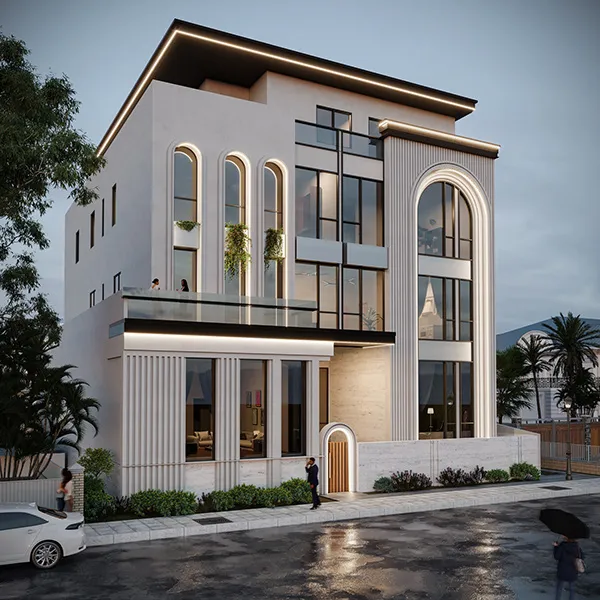Table of Contents

Architectural visualization plays a crucial role in the design industry, as it allows designers and clients to visualize a project before it is even built. By creating realistic and immersive visual representations of architectural designs, architects and designers can effectively communicate their ideas and concepts to clients, stakeholders, and other members of the design team. Understanding the value of architectural visualization is therefore essential for both designers and clients alike.
Understanding the Value of Architectural Visualization
Architectural visualization offers a wide range of benefits that help to streamline the design process and improve design outcomes. One of the primary advantages of architectural visualization is its ability to bring designs to life, allowing designers to visually communicate their ideas in a way that words alone cannot capture. With the help of realistic 3D renderings and animations, clients can gain a clear understanding of how the final project will look and feel, even before construction begins.
In addition to its visual appeal, architectural visualization also allows for better decision-making throughout the design process. Designers can use virtual models to test different design options and evaluate their impact on the overall space. By exploring various possibilities and making informed decisions, designers can optimize the design to meet the specific needs and preferences of the client.
Furthermore, architectural visualization plays a crucial role in enhancing collaboration between architects, designers, and clients. By providing a visual representation of the design, all stakeholders can have a shared understanding of the project, reducing miscommunication and ensuring everyone is on the same page. This collaborative approach fosters effective communication and enables the team to work together seamlessly towards a common goal.
Moreover, architectural visualization allows for effective marketing and presentation of design concepts. With visually stunning and immersive presentations, architects and designers can showcase their ideas to potential clients, investors, and stakeholders. These presentations can include interactive elements, such as virtual tours, which allow viewers to explore the space and experience it firsthand, creating a lasting impression and generating excitement about the project.
Another advantage of architectural visualization is its ability to save time and resources. In traditional design processes, creating physical models or prototypes can be time-consuming and expensive. With architectural visualization, designers can create virtual models and make changes quickly and easily, without the need for physical materials. This not only speeds up the design process but also reduces costs associated with material procurement and construction.
Furthermore, architectural visualization enables designers to anticipate and address potential design issues early on. By visualizing the project in a virtual environment, designers can identify any flaws or challenges that may arise during the construction phase. This early detection allows for timely modifications and adjustments, minimizing the risk of costly mistakes and ensuring a smoother construction process.
Lastly, architectural visualization empowers clients to actively participate in the design process. By providing them with a visual representation of the project, clients can provide valuable feedback and suggestions, contributing to the refinement of the design. This collaborative approach not only enhances client satisfaction but also ensures that the final design aligns with their vision and requirements.
The Benefits of Incorporating Architectural Visualization
By incorporating architectural visualization into the design process, architects and designers can achieve numerous benefits. Firstly, it helps in communicating design concepts effectively. Traditionally, designers would rely on 2D drawings or blueprints, which can be challenging for clients to interpret. However, with the use of architectural visualization, designers can present their ideas in a visually appealing and easily understandable manner.
Secondly, architectural visualization saves time and costs. By allowing clients and designers to visualize the project in detail beforehand, any design flaws or changes can be identified early on, avoiding expensive modifications later in the construction process. This not only saves money but also minimizes delays and ensures a smoother overall project execution.
Another key benefit of architectural visualization is its marketing potential. Realistic visualizations can help architects and developers attract potential buyers or investors by showcasing the project’s features and benefits. These visualizations can be used in marketing materials, presentations, or online platforms, maximizing the project’s exposure and generating interest.
How Architectural Visualization Enhances the Design Process
Architectural visualization enhances the design process by providing designers with a powerful tool to communicate their vision effectively. With the ability to create detailed virtual models and renderings, designers can demonstrate the design intent, showcasing various elements such as materials, lighting, and spatial arrangements. This level of detail helps clients to visualize the final outcome accurately, promoting better collaboration and alignment.
Furthermore, architectural visualization allows for iterative design improvements. Designers can receive immediate feedback from clients and iterate on the design based on their preferences or suggestions. This iterative process promotes an iterative and collaborative approach to design, resulting in better design outcomes and client satisfaction.
Moreover, architectural visualization can also be used as a tool for design exploration. By experimenting with different design options virtually, designers can assess their feasibility and impact on the overall design. This flexibility helps in pushing boundaries and exploring new design ideas, resulting in innovative and unique architectural solutions.


Exploring the Impact of Architectural Visualization on Design Outcomes
Architectural visualization has a significant impact on design outcomes, as it helps bridge the gap between ideas and reality. By providing clients with a realistic and immersive visual experience, architectural visualization enables them to make more informed decisions about the design. This leads to improved design outcomes that align with the client’s expectations and requirements.
Furthermore, architectural visualization facilitates effective communication and collaboration among stakeholders. Designers can share virtual models and renderings with clients, consultants, and contractors, allowing for better understanding and coordination. This collaboration ensures that all parties involved have a clear picture of the design intent, resulting in a smoother and more efficient project execution.
Unlocking the Power of 3D Architectural Visualization
3D architectural visualization takes architectural visualization to the next level by creating highly realistic and immersive visual representations. With advancements in technology, designers can now create detailed virtual environments that simulate lighting, textures, and materials more accurately. These realistic visualizations not only aid in design decision-making but also help clients envision themselves in the space.
Additionally, 3D architectural visualization allows for virtual tours and walkthroughs, enabling clients to experience the design from different perspectives. This interactive and engaging experience helps clients to better understand the spatial qualities of the design, fostering a deeper connection and appreciation for the project.
Exploring the Role of Architectural Visualization in the Design Industry
The role of architectural visualization in the design industry is multifaceted. It serves as a powerful tool for designers to communicate their ideas effectively, gain client buy-in, and streamline the design process. It also enables clients to make more informed decisions and visualize the end result before construction begins.
Furthermore, architectural visualization has become an essential component of design presentations and marketing strategies. With realistic visualizations, architects and developers can showcase their projects in a compelling and visually appealing manner, attracting potential clients and investors.
Assessing the Benefits of Architectural Visualization for Clients
Clients stand to gain numerous benefits from architectural visualization in the design process. Firstly, it provides them with a clear understanding of the design concept and allows them to visualize the final outcome accurately. This helps clients make informed decisions and ensures that their expectations are met.
Moreover, architectural visualization helps in avoiding potential design flaws or changes, reducing unnecessary costs and delays. Clients can actively participate in the design process by providing feedback and collaborating with the design team, resulting in a design that aligns with their preferences and needs.
Harnessing the Power of Architectural Visualization for Designers
For architects and designers, architectural visualization is a powerful tool that can enhance their design process and improve their overall design outcomes. By harnessing the power of architectural visualization, designers can effectively communicate their ideas, test design options, and receive immediate feedback from clients.
Incorporating architectural visualization into their workflow allows designers to explore innovative design ideas and push the boundaries of creativity. The ability to create virtual environments and realistic renderings empowers designers to showcase their design intent convincingly, ultimately leading to greater client satisfaction.
Enhancing the Design with Architectural Visualization
Architectural visualization offers designers the opportunity to enhance their designs by providing a more engaging and immersive experience. By using virtual reality (VR) or augmented reality (AR) technologies, designers can enable clients to explore and interact with the design in a more dynamic and interactive manner.
Moreover, architectural visualization allows for fine-tuning of design details. By visualizing the design in 3D, designers can modify and refine elements such as lighting, materials, and furniture placement, ensuring that every aspect of the design is optimized and aligns with the client’s vision.
Maximizing the Benefits of Architectural Visualization
To maximize the benefits of architectural visualization, designers and clients should collaborate closely throughout the design process. By involving clients from the early stages and regularly seeking feedback, designers can ensure that the visualization accurately reflects the client’s vision and preferences.
Furthermore, designers should embrace new technologies and advancements in architectural visualization, such as VR and AR, to create more immersive and engaging experiences for clients. By staying up-to-date with the latest tools and techniques, designers can push the boundaries of architectural visualization and achieve truly remarkable design outcomes.
In conclusion, architectural visualization is of utmost importance in the design industry. Its ability to bring designs to life, facilitate effective communication, and enhance decision-making makes it an invaluable tool for designers and clients alike. By harnessing the power of architectural visualization and embracing technological advancements, designers can unlock their full creative potential and deliver exceptional design outcomes.


